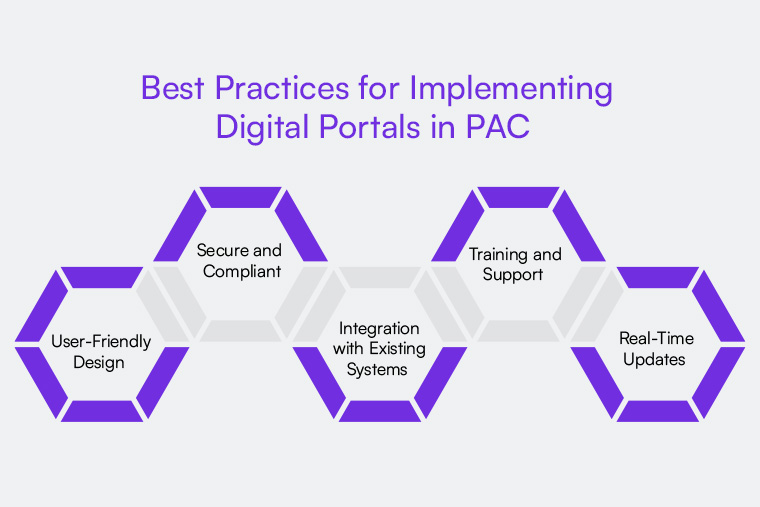1. Introduction: The Growing Role of Digital Solutions in PAC
Post-acute care (PAC) plays a vital role in the healthcare system, ensuring that patients who no longer require acute hospital care receive the necessary follow-up care in settings such as skilled nursing facilities (SNFs), home health agencies, and rehabilitation centers. However, despite its importance, PAC faces several challenges that can lead to complications, such as miscommunication, poor care coordination, and inadequate monitoring of patients.
To address these challenges, digital solutions—specifically digital portals—are gaining traction. These portals provide healthcare providers, patients, and caregivers with secure access to vital health information, improving communication and collaboration across the care continuum. In this blog, we will explore how digital portals can reduce PAC complications by enhancing care coordination, monitoring, and communication.
2. What Are Digital Portals and How Do They Work in PAC?

A digital portal is a secure online platform that allows healthcare providers, patients, and their caregivers to access and share health information in real-time. In the context of post-acute care, digital portals serve as a bridge to improve the continuity of care, reducing the risk of complications during a patient's recovery.
How Digital Portals Work in PAC:
- Patient Data Access: Patients and their healthcare providers can access important information such as medical histories, discharge plans, medications, lab results, and upcoming appointments.
- Communication Tools: Digital portals facilitate secure messaging between patients, caregivers, and healthcare providers, allowing them to discuss symptoms, treatment plans, or concerns without waiting for an in-person visit.
- Care Coordination: By integrating with other systems (like EHRs or care management tools), digital portals help to ensure all care providers are on the same page, improving decision-making and reducing the risk of gaps in care.
- Patient Engagement: Many portals include features like symptom trackers, reminders for medications or appointments, and educational materials to help patients actively participate in their recovery.
These features make digital portals an essential tool for improving patient management in post-acute care settings, ultimately reducing complications and improving outcomes.
3. The Key Complications in PAC and How Digital Portals Help

PAC patients often face several complications, including infections, medication errors, readmissions, and poor recovery outcomes due to a lack of follow-up care. These complications can be significantly mitigated by utilizing digital portals for better monitoring, communication, and care coordination.
3.1 Medication Errors
One of the most common complications in PAC is medication errors, including incorrect dosages, missed medications, or dangerous drug interactions. Inadequate communication between healthcare providers and patients can exacerbate this problem.
How Digital Portals Help:
- Digital portals allow healthcare providers to track and update medication lists in real-time, ensuring that all team members are aware of the patient’s medication regimen.
- Automated medication reminders can be sent to patients and caregivers to ensure that doses are taken on time.
- The integration of digital portals with Electronic Health Records (EHRs) helps reduce the risk of errors caused by outdated or incorrect medication data.
3.2 Delayed Recovery
Infections, particularly among post-surgical or recently discharged patients, are a leading cause of delayed recovery. Wound care issues—such as improper dressing changes or unnoticed infections—can compound the problem, potentially leading to serious complications if not addressed early.
How Digital Portals Help:
- Providers can track wound healing progress through secure digital portals, reviewing photo uploads and patient-submitted updates for signs of delayed healing or infection.
- Patients and caregivers can share real-time information, allowing clinicians to provide guidance without requiring in-person visits.
- Built-in messaging systems make it easier for patients to report changes or concerns immediately, supporting faster responses and reducing recovery delays.
3.3 Poor Follow-Up Care and Readmissions
Readmissions to hospitals are costly and detrimental to patient health, often occurring due to gaps in post-acute care, such as missed follow-up appointments or insufficient monitoring after discharge.
How Digital Portals Help:
- Digital portals streamline appointment scheduling and reminders, ensuring that patients attend follow-up visits on time.
- Providers can track patient progress remotely and adjust treatment plans as needed, ensuring patients stay on track with their recovery.
- Real-time access to patient data, such as vital signs or post-surgical recovery status, allows care teams to intervene proactively if any issues arise, reducing the need for readmissions.
3.4 Lack of Patient and Family Engagement
Patients and their caregivers often feel disengaged from the recovery process due to a lack of education or clear communication about their care plans. This disengagement can lead to poor outcomes, non-compliance with medications, and ultimately, more complications.
How Digital Portals Help:
- Digital portals offer educational materials that empower patients and their families with the knowledge they need to actively participate in the recovery process.
- By allowing patients and caregivers to access their medical records and track progress, digital portals help them feel more in control of the care process, leading to better adherence to prescribed treatments and a more active role in decision-making.
4. Benefits of Using Digital Portals in Post-Acute Care

Using digital portals in PAC settings can provide numerous advantages, both for patients and healthcare providers. Here are some key benefits:
4.1 Enhanced Communication
One of the primary benefits of digital portals is the improved communication they facilitate. By allowing patients, caregivers, and healthcare providers to securely exchange messages, updates, and questions, portals create an ongoing dialogue that ensures that care is continuous, accurate, and coordinated.
4.2 Improved Monitoring and Early Intervention
Digital portals enable real-time monitoring of patients' conditions and allow for early intervention when problems arise. Providers can quickly identify changes in a patient’s health status, such as symptoms of infection or worsening pain, and adjust treatment plans accordingly. This timely intervention helps to prevent complications from escalating.
4.3 Better Care Coordination
Digital portals integrate data from various healthcare systems, allowing all care providers to access the same up-to-date patient information. This enhances care coordination and reduces the likelihood of duplicated services, conflicting treatments, or miscommunications that could lead to complications.
4.4 Increased Patient Engagement
By providing patients with easy access to their health data, educational resources, and communication tools, digital portals promote patient engagement. When patients and caregivers are informed and involved in the care process, they are more likely to follow treatment plans and attend follow-up appointments, leading to better outcomes.
4.5 Streamlined Administrative Processes
Digital portals automate many administrative tasks, such as appointment scheduling, medication reminders, and data entry, which reduces the burden on healthcare staff. This efficiency allows providers to focus more on delivering care and less on managing logistics.
5. Best Practices for Implementing Digital Portals in PAC

While digital portals offer numerous benefits, their effectiveness depends on how well they are implemented. Here are some best practices for hospitals and PAC facilities to consider:
5.1 User-Friendly Design
The portal should be easy to navigate for both patients and providers. A user-friendly interface with clear instructions and intuitive design will ensure that both parties can access the information they need without frustration.
5.2 Secure and Compliant
It’s critical that digital portals comply with healthcare regulations such as HIPAA to protect patient privacy and ensure data security. Secure login systems, encryption, and regular security updates are essential components of a compliant digital portal.
5.3 Integration with Existing Systems
For digital portals to be effective, they must integrate seamlessly with existing EHRs, patient management systems, and other healthcare software. This ensures that all patient data is accessible in one place and that the portal supports healthcare workflows rather than disrupting them.
5.4 Training and Support
Both patients and healthcare providers should be adequately trained on how to use the digital portal. Offering support services, such as help desks or tutorials, will help users maximize the portal’s capabilities and reduce barriers to adoption.
5.5 Real-Time Updates
Providing real-time access to updates—such as medication changes, appointment reminders, lab results, or discharge instructions—can significantly improve communication and care coordination. Timely information keeps patients informed and helps care teams respond faster to changing needs during the post-acute recovery phase.
6. Conclusion: How Cabot Technology Solutions Can Help Hospitals Improve PAC Management
Digital portals are transforming the way healthcare providers manage post-acute care by improving communication, monitoring, and patient engagement. By using digital portals, hospitals and care facilities can reduce complications, enhance care coordination, and provide a more positive recovery experience for patients.
At Cabot Technology Solutions, we specialize in developing custom healthcare solutions, including digital portals that integrate seamlessly with your existing systems. Our team can help your facility improve PAC management, reduce complications, and enhance patient care.
Are you ready to reduce complications and enhance patient outcomes in post-acute care? Contact Cabot Technology Solutions today to discover how our digital portal solutions can help your hospital or PAC facility streamline operations, improve care coordination, and provide better outcomes for your patients.

